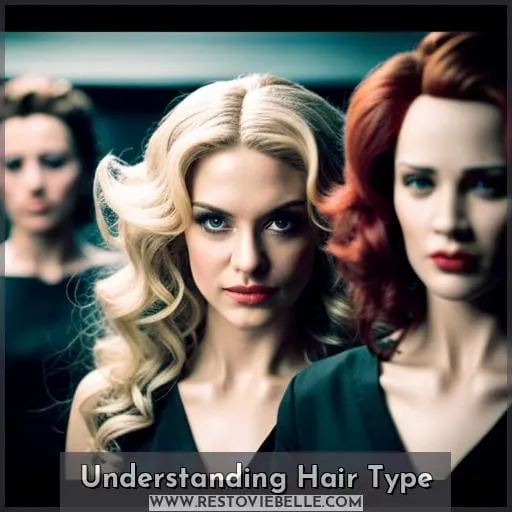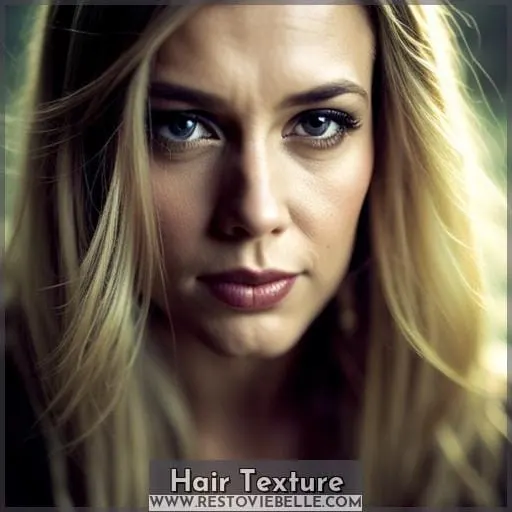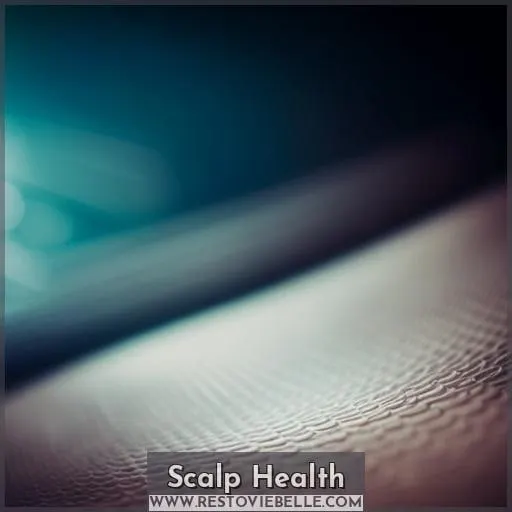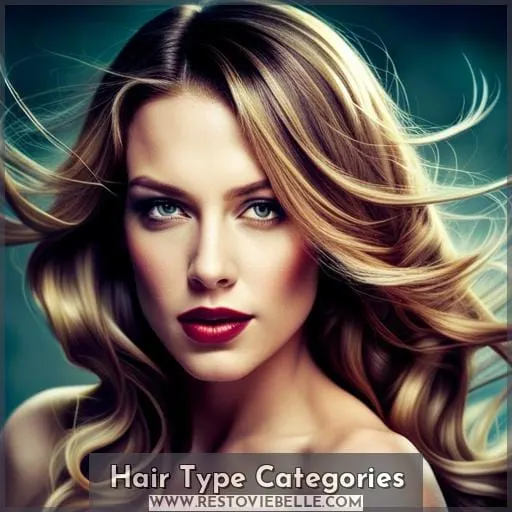This site is supported by our readers. We may earn a commission, at no cost to you, if you purchase through links.
 Do you know your hair type? It’s an important factor to consider when it comes to choosing the right haircare products for your locks. Being mindful of texture, structure, and porosity can help determine which treatments will be best suited for nourishing your mane.
Do you know your hair type? It’s an important factor to consider when it comes to choosing the right haircare products for your locks. Being mindful of texture, structure, and porosity can help determine which treatments will be best suited for nourishing your mane.
Whether you have straight or wavy hair, understanding how porous each strand is and what condition your scalp is in can make all the difference when it comes to achieving healthy-looking tresses.
Let’s take a closer look at recognizing these key elements that define our individual hair types so we can start giving our locks what they need!
Table Of Contents
Key Takeaways
- Hair types include straight, wavy, curly, and coily.
- Hair texture can be identified through touch and visual cues.
- Hair porosity can be high or low, affecting how hair absorbs moisture.
- Consulting with professional stylists can provide guidance on recognizing and caring for your hair type.
Understanding Hair Type
Gaining an understanding of your unique hair type is essential for unlocking its natural beauty and tailoring a care routine that works best for you. Hair types can be divided into four main categories: straight, wavy, curly, or coily.
Each category has variations in texture and subtype, as well as follicle shape and structure, such as fine to coarse strands.
Additionally, the porosity of your hair plays an important role in determining how much moisture it absorbs. High porosity means a hydrated but dry scalp, while low porosity results in product buildup.
Knowing this will help guide you towards products specifically tailored to suit your needs precisely.
To figure out what type of hair you have exactly, there are several ways you could go about doing this. You can take online quizzes or use a simple float test at home. Another option is to get professional advice from experts who specialize in styling certain types.
Their experience working with various textures over time allows them to provide accurate results more quickly than if done alone without any guidance.
The end goal should always focus on achieving balanced scalps, which ultimately leads to healthier locks overall. When our roots are healthy, we reap the rewards aesthetically speaking day after day, after shampooing, conditioning, moisturizing, and styling according to the natural state of our beautiful crowns.
Hair Texture
Feel the texture of your hair to help determine its type. Hair type is determined by a combination of factors, including texture, porosity, and density. Each has an impact on how you care for your locks and what products are best suited for them.
When it comes to recognizing hair types using texture identification techniques such as touch or sight can be helpful in determining subtypes within each category like straight (1), wavy (2), curly (3), or coily (4).
To start with, feel the strands between two fingers – if they feel thin, then it’s likely that you have fine hair. Thick strands mean coarse-textured tresses, while smooth but not too thin stands suggest medium-textured locks.
Visual cues can also provide insights into one’s specific hair type – tight curls mean Type 4a/b, whilst undefined coils suggest a Type 4c classification system.
Porosity plays an important role in identifying which haircare routine is right for you, plus gives clues about product recommendations needed to maintain a healthy-looking mane over time! For high porosity, one needs lots of hydration, so look out for lightweight creams, oils, shampoos, conditioners, moisturizers that fill gaps and moisture quickly absorbent without leaving behind any residue or build-up.
If low porosity, use heavier formulas to protect from excessive absorption, thereby reducing dryness and breakage.
Ultimately, understanding your own individual characteristics helps create a tailored plan ensuring optimal results, styling tips, personalized advice, and achieving desired goals – results in beautiful, happy, head full of luscious, lush, vibrant, healthy, manageable, and bouncy tresses.
Hair Structure
Discovering your hair structure is key to finding the best products for your needs. Hair type includes categories like straight, wavy, curly, and coily, which are determined by curl pattern. This can further be divided into subcategories within each type depending on the curl pattern.
To determine hair structure, you need to identify fine strands, which hold curls well but do not have great styling retention; medium strands, which are relatively easy to style and maintain their shape; or thick strands, which take longer time for styling but possess good hold of styles once done correctly.
Finding out if you have high porosity (which absorbs moisture quickly), low porosity (that cannot absorb moisture easily), or a balanced scalp requires a careful examination of how much water it takes in when testing with the float test or absorption test methods respectively.
Thick hairs require more product than finer ones as they lack movement. Hence, proper usage is necessary to avoid buildup from using too much product at once. Fine hairs require less attention due to their delicate nature, so being cautious while using shampoo/conditioner will help retain healthy-looking locks without damaging them in the long run.
Medium-length hairstyles may need extra care initially; however, after a few trials, a regular routine can be established according to suitable products depending upon individual’s texture variation.
Proper assessment of one’s own hair, combined with expert advice, helps achieve the desired look sustainably, ultimately leading towards liberation, power, and mastery over one’s appearance!
Hair Porosity
Understanding your hair porosity is key to achieving vibrant, healthy hair. There are two main categories of porosity: high and low. High porosity locks absorb moisture quickly but can become dry, while low porosity strands resist absorption and may suffer from product buildup.
High Porosity
Understanding your high porosity hair is key to keeping it healthy and hydrated. Can you identify if yours absorbs moisture quickly or with difficulty? To answer this, tackle the Porosity Test. This test will help determine how easily your strands absorb moisture and retain it.
You’ll then be armed with essential information when making informed hair care decisions for natural beauty.
For a successful result, use products specifically designed for high porosity, such as deep conditioning masks, leave-in serums, oil sprays, and treatments that promote the retention of water molecules in each strand.
All while maintaining excellent scalp health! Properly applied moisturizers are also beneficial since they create an extra layer of protection on top of naturally porous locks, helping them keep their shine longer than usual.
Lastly, don’t forget about protecting against sun damage by using SPF-infused creams or oils before going outdoors to prevent further dryness from occurring due to UV exposure.
- Porosity Test
- Moisture Retention Products
- Hair Health Protection
- Sunscreen Application
With these tips in mind, you’ll be able to confidently manage any type of hair texture without fear or hesitation! A better understanding leads directly into more control over one’s own image, allowing individuals an opportunity at self-expression like never before – revealing beautiful results every time!
Low Porosity
Unlock the secret to healthy hair with low porosity – allowing your luscious locks to stay hydrated and vibrant. Low porosity is characterized by a difficulty in absorbing moisture, making it essential for you to properly assess your hair type before selecting products or styling tips.
A proper analysis of this trait requires knowledge about categories such as fine, medium coarse strands; straight, wavy curly, and coily types; or oily scalp versus dry scalp balance needs.
| Hair Type | Porosity Testing | Product Selection |
|---|---|---|
| Straight | Float Test | Oil Control Products |
| Wavy | Water Absorption Test | |
| Curly | Tight Coils | Hydrating Shampoos |
| Undefined Coils | Natural Ingredients & Innovation |
Achieving well-hydrated tresses starts with understanding what kind of care each strand requires for balanced natural beauty while addressing misconceptions about these traits like product buildup due solely to low porosity levels when often oiliness is also an issue that should be addressed too!
Get ready for healthier-looking locks today through a customized haircare routine selection tailored specifically towards individualized needs based on unique categorization methods!
Scalp Health
Recognizing your hair type is the key to a healthy scalp. An oily scalp can be caused by an overproduction of sebum, while a dry scalp lacks sebum, leading to dryness and breakage. By understanding your hair type and identifying the signs of either condition, you can take steps towards achieving healthier scalps with appropriate products tailored for optimal results.
Oily Scalp
Experiencing an oily scalp? Greasiness and dandruff can be the result of overproduction of sebum, making it important to restore balance for healthy hair.
To combat excess oil:
- Implement a regular hair care routine that utilizes products designed specifically for your scalp type.
- Find ways to manage oil secretion through natural methods such as apple cider vinegar rinses or using gentle shampoos every few days.
- Seek out advice from professionals who specialize in oily scalps and create a personalized program tailored just for you!
Finding solutions to an oily scalp is possible with patience and dedication. A balanced, healthy scalp leads to vibrant locks! A combination of knowledge about what works best on your unique head-scape, the right ingredients in haircare products, and expert guidance if needed—all these elements will help keep those greasy roots at bay while nourishing the rest of your mane into perfection!
Dry Scalp
Discover how a lack of sebum can lead to dryness and breakage in your scalp, and learn how to restore balance.
Having a dry scalp is common with some hair types, such as fine or coarse strands, which are more prone to moisture loss. Hydrating remedies that focus on replenishing the lost moisture will help you keep it healthy for years.
Product recommendations like hydrating shampoos, followed by conditioners enriched with natural ingredients, are essential for preventing the dryness from worsening. Additionally, avoiding excessive heat styling tools, washing your hair less often, and using protective products when styling will all aid in retaining moisture levels within the scalp.
Scalp care tips, such as massaging oil into your roots regularly, also help maintain balance at home while allowing any nutrients vital for its health to reach deep below the surface of each strand of hair too!
To seal this routine off perfectly, look out for haircare ranges specifically designed to tackle troublesome scalps.
Hair Type Categories
Do you know your hair type? Recognizing the differences between straight, wavy, curly, and coily strands is essential for effective hair care. Straight hair is characterized by a 1 shape with no bends or curves (type 1), while wavy forms a slight S pattern (type 2).
Straight Hair
Embrace the sleekness of straight hair with type 1, characterized by its long, thin strands. Get creative and experiment with Straight Hair Care products for diverse styles. Try styling tips like a deep side part to add texture and movement to your look.
Managing straight hair can be tricky as it tends to get oily quickly, so incorporate regular cleansing into your hair regimen. Use nourishing products such as oils and masks to maintain healthy hair. This will also reduce frizziness caused by static electricity.
Maintaining your desired style is essential for a beautiful finish. Find the right product combination specific for straight hair while avoiding over-manipulation of delicate locks!
Wavy Hair
Feel the slight S-shape as you run your fingers through your wavy locks. Wavy hair can be tricky to manage, but with the right techniques and products, it’s possible to create stunning looks.
To care for your wavy hair, use a hydrating shampoo and condition regularly. After washing, apply leave-in treatments and consider deep conditioning once or twice a month. When styling with hot tools, use a heat protectant and try air drying instead of blow drying whenever possible.
To define curls and minimize frizziness, you can use products like mousses, gels, and curl creams. Experimenting with different hairstyling tools, such as diffusers, can also help enhance waves without causing further damage.
By following proper maintenance routines tailored specifically for wavy hair types, you’ll have gorgeous tresses in no time!
Curly Hair
Unlock your inner beauty with curly hair! Type 3 hair has springy ringlets that can be difficult to style but offers unique volume and texture. Beyoncé’s natural curls are iconic for a reason – they show the potential of embracing our own beautiful curls.
To get the most from them, use curl care products, styling tips, and moisture management techniques to enhance patterned coils that suit you best.
Coily Hair
Discover your coily hair type – characterized by dense spirals and zig-zag patterns – for a healthy, vibrant look. Get the most out of your locks with Coily Hair Care Tips: Moisture management is key! Hydrate regularly and use products tailored to preserve natural oils.
Take the Hair Type Quiz to determine if you have undefined coils or tight curls.
How to Determine Your Hair Type
Knowing your hair type is key to rocking a killer ‘do, so let’s figure it out! There are several ways you can determine what kind of locks you have.
Start with the Hair Type Quiz and see if that gives you some clues about where your hair falls in the classification system. Then try a Hair Texture Test – run your fingers through wet or dry strands to help identify whether they are fine, medium, or coarse.
To check for porosity levels, use an assessment like the float test. Submerge a strand in water and observe how quickly it absorbs moisture. This helps indicate how easy (or not) it is for product absorption on the scalp level.
Lastly, consult with professional stylists who specialize in personalized care regimens tailored specifically for each individual’s needs. They can help identify the sebum production balance between oily and dry scalps before recommending products best suited for their client’s unique situation and desired results.
From quizzes to tests to consultations, understanding your hair type has never been easier! With these tips at hand, there’s nothing stopping us from having healthy, beautiful tresses.
Conclusion
Recognizing your hair type is the key to achieving your natural hair goals. With the right knowledge, you can unlock the door to the perfect hair care routine and enjoy the vibrancy of your locks.
By understanding the differences between texture, structure, and porosity, you’ll be able to customize your hair care and discover the ideal balance for your scalp health. Whether you have straight, wavy, curly, or coily locks, you’ll be able to find the correct products and hair care techniques to feel confident and beautiful.
To determine your hair type, consult a professional stylist or take a quiz to learn the specifics of your hair.











